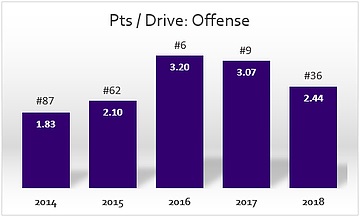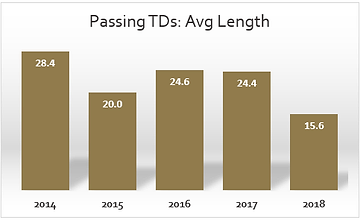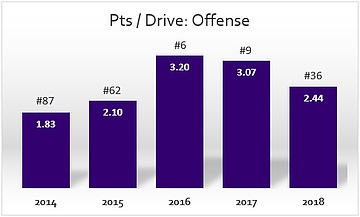Improvement at Receiver is Key to Reviving Offense
The Huskies’ offense was one of the best in FBS, statistically anyway, in 2016, scoring 77 touchdowns and almost 42 points/game. Anybody who watched the games knows that the offense regressed a bit in 2017 and then took a major step back in 2018.Data from cfbstats.com
Whatever you may think of former QB Jake Browning and his play, he is gone and Jacob Eason is the new trigger man for Chris Petersen’s offense. Eason’s physical tools are considerable and he has shown good discipline in terms of ball security during the public scrimmages since last spring. Unlike his predecessor, Eason has displayed a willingness to check the ball down to secondary targets quickly.
Checking the ball down may be a very necessary skill for Eason in 2019, as a primary cause of the offense’s regression since 2016 has been the loss of WRs John Ross and Dante Pettis to the NFL and the general inability of their replacements to come close to matching their ability to gain separation or create plays in the passing game.Data from bcftoys.com (excludes FCS opponents and garbage time possessions)
Ross and Pettis made the offense go in 2016. After Ross left, the offense took a step back, but Pettis was could still get open downfield when it was really needed, and Hunter Bryant established himself as a second real threat in the passing game in his hybrid TE role. With Pettis having moved on to the San Francisco 49ers and Bryant plagued by injuries for much of the year, the wheels came off the passing game last season.

The impact of having a receiving corps that couldn’t get much separation and didn’t make a lot of plays, even when they were there for the taking, is really evident when you peel back the onion a bit on scoring efficiency.


BDTW calculations, based on data from collegefootballdata.com (FCS opponents excluded)
The lack of threat posed by the Huskies’ receivers last season allowed opponents to crowd the line of scrimmage at all levels of the defense. That made it harder on Myles Gaskin in the running game, not that you’d be able to notice it much from his production, but the Dawgs were not able to make opponents pay for this tactic by getting over the top very often. Opponents’ safeties were very successful in keeping everything in front of them in 2018. By way of illustration, the average length of UW TD passes dropped dramatically last season.Data from cfbstats.com
That same inability to gain separation and lack of play-making was also very evident in the Huskies’ Red Zone efficiency last season. We all know about the problems in the kicking game, and that was a real issue, but it was really magnified by the inability of the Washington offense to get the ball into the End Zone when it was close. Fewer long TDs and sharply reduced Red Zone scoring efficiency is not a great combo.
These concerns are all magnified by the loss of Gaskin, who was not just awesome, but consistently awesome throughout his career. Salvon Ahmed has tremendous potential as a break-away threat, but has yet to show the kind of instincts and durability that made Gaskin the most productive RB in Washington history. So it isn’t really fair to expect the same kind of production out of Ahmed, which means that the passing offense better improve, or the offense will be hurting once again.
Clearly having a QB like Eason with elite arm strength and high level ball placement should help, but is it enough all by itself? Can veterans like Aaron Fuller, Andre Baccellia, and Ty Jones step it up in a big way under new WR Coach Junior Adams? And can Chico McClatcher regain his 2016 form? Or will youngsters like Austin Osborne, Terrell Bynum, and Puka Nacua need to provide that spark?


0 Comments